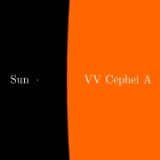
VV Cephei
Encyclopedia
VV Cephei, also known as HD 208816, is an eclipsing binary star system located in the constellation
Cepheus
, approximately 2,400 light years from Earth.Size, mass and luminosity estimates are all considerably uncertain due to insufficient knowledge of the Cephei star system: Professor Kaler writes "in truth we really do not know". Its distance cannot be measured from parallax; instead it is derived from its assumed membership in the Cepheus OB2 association, but this is also not certain. Other methods give a range of sizes between 1000 and 2200 that of the Sun, but these too are confounded by the fact that the star is not spherical, which leads to overestimates. (J. Kaler)
A red hypergiant
fills the system's Roche lobe
when closest to its companion blue star, the latter appearing to be on the main sequence
. Matter flows from the red hypergiant onto the blue companion. The red hypergiant, known as VV Cephei A, is currently recognised as the second largest star known, with an estimated solar radius between 1,600 and 1,900. Like Betelgeuse
, VV Cephei A is plagued by phenomena intrinsic to hypergiant stars that make them difficult to measure with precision. VV Cephei is not entirely spherical, and is surrounded by opaque shells of a highly extended atmosphere, which, coupled with limb darkening
, unstable luminosity and other factors, make it difficult to determine its true size. It has a very small parallax
, so estimates as to its distance, and consequently, most other deductions made about its nature, have a high margin of error.
Constellation
In modern astronomy, a constellation is an internationally defined area of the celestial sphere. These areas are grouped around asterisms, patterns formed by prominent stars within apparent proximity to one another on Earth's night sky....
Cepheus
Cepheus (constellation)
Cepheus is a constellation in the northern sky. It is named after Cepheus, King of Aethiopia in Greek mythology. It was one of the 48 constellations listed by the 2nd century astronomer Ptolemy, and remains one of the 88 modern constellations.-Stars:...
, approximately 2,400 light years from Earth.Size, mass and luminosity estimates are all considerably uncertain due to insufficient knowledge of the Cephei star system: Professor Kaler writes "in truth we really do not know". Its distance cannot be measured from parallax; instead it is derived from its assumed membership in the Cepheus OB2 association, but this is also not certain. Other methods give a range of sizes between 1000 and 2200 that of the Sun, but these too are confounded by the fact that the star is not spherical, which leads to overestimates. (J. Kaler)
A red hypergiant
Hypergiant
A hypergiant is a star with a tremendous mass and luminosity, showing signs of a very high rate of mass loss.-Characteristics:...
fills the system's Roche lobe
Roche lobe
The Roche lobe is the region of space around a star in a binary system within which orbiting material is gravitationally bound to that star. If the star expands past its Roche lobe, then the material can escape the gravitational pull of the star. If the star is in a binary system then the material...
when closest to its companion blue star, the latter appearing to be on the main sequence
Main sequence
The main sequence is a continuous and distinctive band of stars that appears on plots of stellar color versus brightness. These color-magnitude plots are known as Hertzsprung–Russell diagrams after their co-developers, Ejnar Hertzsprung and Henry Norris Russell...
. Matter flows from the red hypergiant onto the blue companion. The red hypergiant, known as VV Cephei A, is currently recognised as the second largest star known, with an estimated solar radius between 1,600 and 1,900. Like Betelgeuse
Betelgeuse
Betelgeuse, also known by its Bayer designation Alpha Orionis , is the eighth brightest star in the night sky and second brightest star in the constellation of Orion, outshining its neighbour Rigel only rarely...
, VV Cephei A is plagued by phenomena intrinsic to hypergiant stars that make them difficult to measure with precision. VV Cephei is not entirely spherical, and is surrounded by opaque shells of a highly extended atmosphere, which, coupled with limb darkening
Limb darkening
Limb darkening refers to the diminishing of intensity in the image of a star as one moves from the center of the image to the edge or "limb" of the image...
, unstable luminosity and other factors, make it difficult to determine its true size. It has a very small parallax
Parallax
Parallax is a displacement or difference in the apparent position of an object viewed along two different lines of sight, and is measured by the angle or semi-angle of inclination between those two lines. The term is derived from the Greek παράλλαξις , meaning "alteration"...
, so estimates as to its distance, and consequently, most other deductions made about its nature, have a high margin of error.
External links
- Space.Com
- Universe Today
- VV Cephei at Kempten observatory
- Aladin image of VV Cephei

